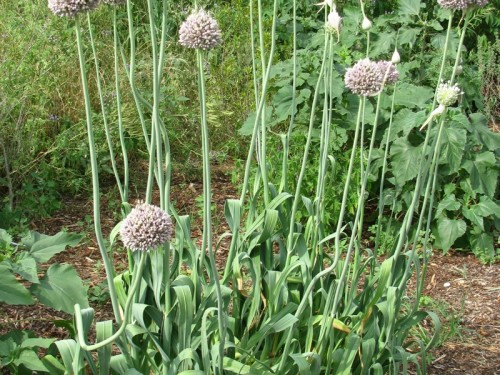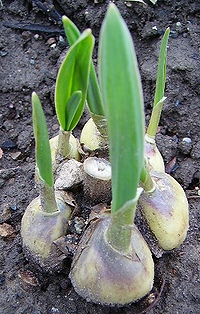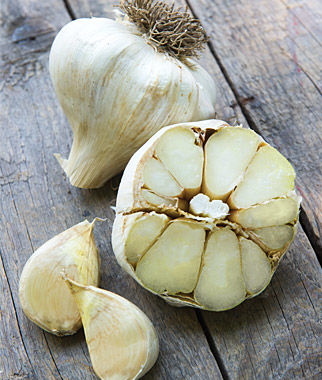
- Garlic plants with their flower heads
General Information
Garlic is a plant cousin to onions, chives, and other such plants. It is an annual plant that has a multi-clove bulb in the ground and a long green stalk with a flower head of many tiny white or purple florets. Garlic can reproduce via its little black seeds. Also, the bulbs can divide or be divided manually and each clove grows into a new plant. Because of this garlic is often considered a perennial since it grows back each year on its own from the cloves’ new plants which are genetically identical to the mother plant.

New plants growing from the garlic cloves
It is thought that garlic first started growing in Middle Asia more than ten thousand years ago. Since then garlic has been cultivated, used as a food and remedy for many ailments, and spread across the world. Many cultures have traditional meals that make use of garlic.

The garlic cloves which are commonly used in food and for medicinal purposes
The bulb is used much more commonly than the long leaves. It has a very strong odor when the flesh is broken into. It is also causes a sensation of heat when eaten. Though the smell and flavor become much milder and sweeter when cooked. This intensity and the medicinal effects of garlic are due largely to its sulfur compounds.
Traditional Uses
Garlic has been used as a natural remedy against multiple ailments from ancient times to our present age and across many cultures. Some cultures and their historical use of garlic are listed here.
- In ancient China garlic was used against depression because of its heating and stimulating effect.
- In ancient India garlic was used with special rituals to treat weakness, coughing, lack of appetite, rheumatism, skin diseases, and more.
- The Egyptians used garlic medicinally and to increase the strength of their slaves.
- It was part of the Ancient Israelis’ religion to eat garlic, they used it to kill parasites, enhance blood pressure, heat the body, and other things.
- The ancient Greeks would eat garlic before their battles and for different remedies including remedies against parasites, colic, snake and mad-dog bites, and seasickness.
- Ancient Tibetans used it to cure stomachaches.
- The Romans also used garlic and thought it was a universal remedy.
- Later, in the seventh century AD, Slavic people used it against lice, spider bites, snakebite, and ulcers.
- In the middle ages, it was used widely as a special remedy and its cultivation was encouraged.
- It was brought to Great Britain in 1548 and then used against helminthes, skin diseases, and dandruff.
- It is thought to have helped control cholera in 1913 and typhoid fever and diphtheria in 1918 in Beirut.
- It was used as a remedy for the great Spanish Fever in 1918.
- The Russians used it as a natural antibiotic in both the World Wars.
For all of these remedies, the garlic was consumed, except for responses to and prevention of bites for which the oils of garlic were applied topically.
The reasons for all these health benefits were not known in ancient times, but they have been undergoing a gradual uncovering. We now know that the sulfur compounds it contains, mainly alliin, allicin, diallyl sulfide, and ajoene, are largely responsible. Here are some of the properties of these compounds.
Sulfur compounds:
- Antibiotic → destroys or stops the growth of microorganisms including bacteria and fungi
- Antilipidemic → reduces the amount of fats in the blood including cholesterol, which lowers the risk of depositing plaques of fat inside your arteries
- Antithrombotic → decreases the formation of blood clots
- Anticarcinogenic → stops the development of cancer
Current Research
Research is currently being done on different methods of preparing garlic so that it can be used most effectively. An example of this is a recent in vitro study comparing the potency of aged and fresh garlic (Elosta et al. 2017). They found that aged garlic had greater potency. Another example is a collection of data on the effects that boiling has on garlic’s sulfur compounds and sulfide-releasing activity (Tocmo et al. 2017). They found that shorter cooking times maintained more of the garlic’s medicinal properties.
There is also a lot of current research supporting the traditional uses of garlic and on further health benefits and how it works (Petrovska and Cekovska 2010). An example of this is a study on sulfur compounds from garlic, they found that they attenuated cardiac hypertrophy and remodeling through induction of a particular transmembrane enzyme (Khatua et al. 2017). There have also been studies looking at the effects of garlic on diabetes at the molecular level (Kaur et al. 2016 and Sultana et al. 2016). They found that garlic reduces oxidative stress, mitochondrial dysfunction, and other pathological effects of diabetes.
References
Elosta, A., Slevin, M., Rahman, K., & Ahmed, N. (2017). Aged garlic has more potent antiglycation and antioxidant properties compared to fresh garlic extract in vitro. Scientific Reports, 7, 39613. http://doi.org/10.1038/srep39613
Kaur, G., Padiya, R., Adela, R., Putcha, U. K., Reddy, G. S., Reddy, B. R., … Banerjee, S. K. (2016). Garlic and Resveratrol Attenuate Diabetic Complications, Loss of β-Cells, Pancreatic and Hepatic Oxidative Stress in Streptozotocin-Induced Diabetic Rats. Frontiers in Pharmacology, 7, 360. http://doi.org/10.3389/fphar.2016.00360
Khatua, T. N., Borkar, R. M., Mohammed, S. A., Dinda, A. K., Srinivas, R., & Banerjee, S. K. (2017). Novel Sulfur Metabolites of Garlic Attenuate Cardiac Hypertrophy and Remodeling through Induction of Na+/K+-ATPase Expression. Frontiers in Pharmacology, 8, 18. http://doi.org/10.3389/fphar.2017.00018
Petrovska, B. B., & Cekovska, S. (2010). Extracts from the history and medical properties of garlic. Pharmacognosy Reviews, 4(7), 106–110. http://doi.org/10.4103/0973-7847.65321
Sultana, R., Bagul, P. K., Katare, P. B., Mohammed, S. A., Banerjee, S. K. (2016)Garlic activates SIRT-3 to prevent cardiac oxidative stress and mitochondrial sysfunction in diabetes. Life Sciences 164:42-51. http://dx.doi.org/10.1016/j.lfs.2016.08.030
Tocmo, R., Wu, Y., Liang, D., Fogliano, V., & Huang, D. (2017). Data on the effect of boiling on the organosulfides and the hydrogen sulfide-releasing activity of garlic. Data in Brief, 10, 221–226. http://doi.org/10.1016/j.dib.2016.11.074
Image Sources
http://www.crankycarlsfarm.com/orderspanishrojagarlic.html
http://www.growyourown.info/page145.html
http://www.burpee.com/vegetables/garlic/
Page created by Maya Audi
